A creamy and savory red sauce Roman classic, Bucatini amatriciana will always impress. A hint of spice and a delicious crunch of rich guanciale make this my absolute favorite pasta dish. Plus it's done in under 30 minutes.
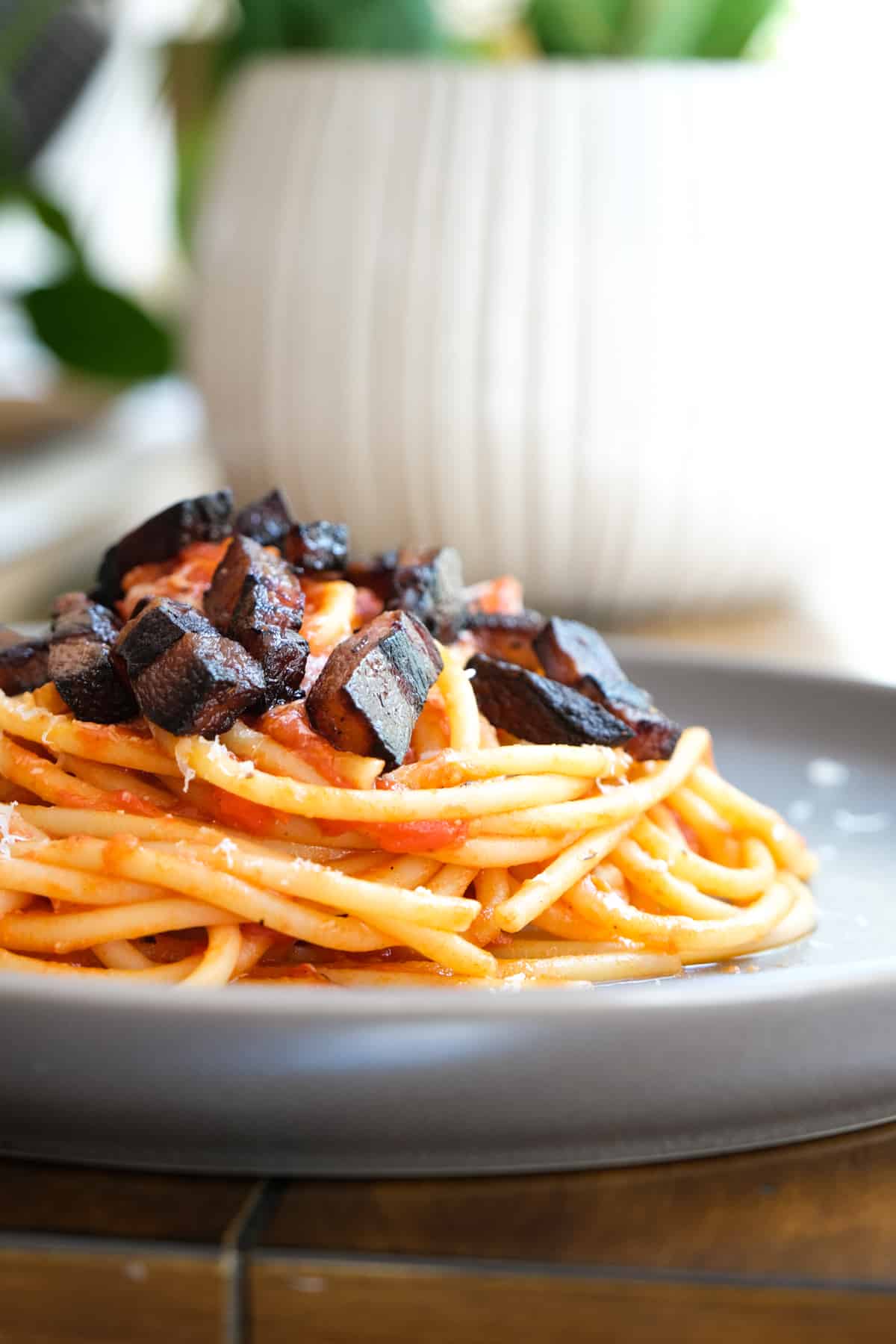
Looking for more classic Italian pasta? Try our Spaghetti Carbonara, Authentic Fettuccine Alfredo, or Pasta alla Norma.
Jump to:
Classic Roman-Italian Dish
Bucatini Amatriciana is one of the four classic Roman-Italian Dishes. It's a slightly spicy tomato sauce made with rich cured pork jowl, pepper, and pecorino. It is simple, high-quality ingredients that make this delicious and complex dish. It's not as spicy as a dish like Shrimp Fra Diavolo with Linguine, but it has a specific kick to it.
Amatriciana has a long history and originally was a white sauce, similar to pasta alla gricia. It wasn't until tomatoes were introduced in Italy that they became a regular part of the dish and that wasn't until Columbus sailed the ocean blue. Originally, in the town of Amatrice, farmers would get together and cook fresh pasta with guanciale (pork jowl) and cheese together with pasta. They used bucatini because it was easy to make the pasta and wrap it around the wire to dry and travel with.
Today, bucatini isn't the only pasta to make amatriciana with. I always see people making it with rigatoni and other popular pasta. Bucatini is the way to go with this dish. The way the pasta fills with sauce makes this dish worth every second. The guanciale is so uniquely flavored, probably the best part of the animal. Sort of like how Sandor Clegane loves pig feet, I love pork jowl.
The Five Simple Ingredients for Amatriciana
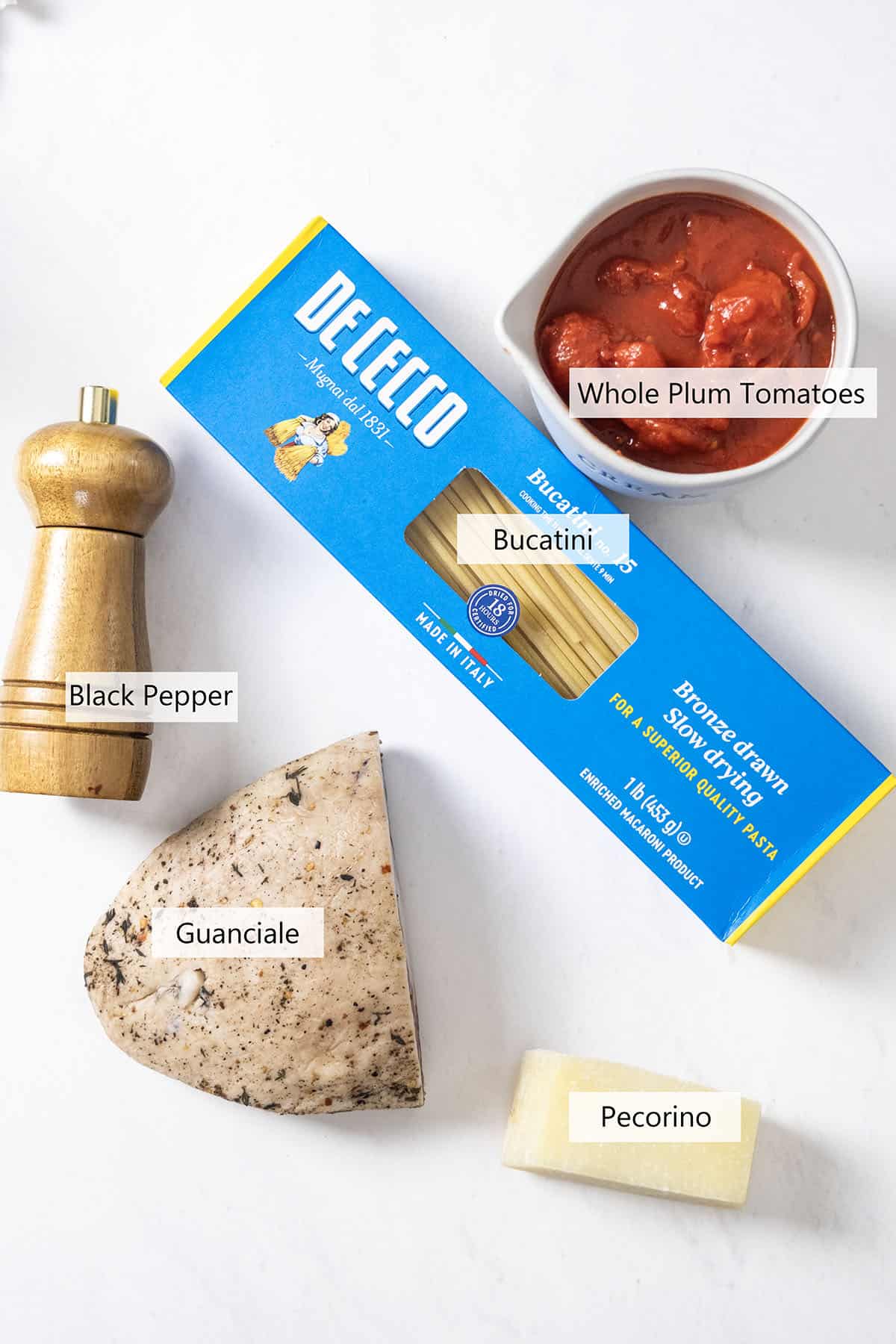
- Guanciale. A rich cured pork jowl. The oil created from the guanciale is what makes bucatini amatriciana so unique.
- Pecorino romano. Pecorino is only pecorino if it is made from sheep's milk. It is more earthy and sharp than parmigiano and has a slight tanginess.
- Black Pepper. I like to add the tiny bit of spice with black pepper. Other recipes call for crushed red pepper. It's my preference but the black pepper is more traditional too.
- Peeled plum tomatoes. The chunkiness of the peeled plum tomatoes breaking down in the oil gives this dish more texture.
- Bucatini. This tubular pasta has a tiny hole in the middle that allows the sauce to enter inside the pasta. Bucatini is the traditional pasta served with amatriciana.
Substitutions for Ingredients in Bucatini Amatriciana
Italians go crazy when you mess with the four Roman dishes, spaghetti carbonara, pasta al gricia, cacio e pepe, and bucatini amatriciana. I've been doing this long enough to know what recipes I can mess with and which I can't.
But, and that's a BIG but, you can substitute pancetta for guanciale in any of these recipes. It won't be exactly the same. It's a fact. Bucatini Amatriciana is so delicious but it will also be delicious with pancetta. Pancetta just tastes different than guanciale, so it's a different flavor. The dish will still be delicious but most people would agree that it is no longer bucatini all'amatriciana.
As for the pecorino romano, you can substitute parmesan if you don't care about the authenticity of the dish. Which I genuinely don't, good food is good food. But when you make bucatini amatriciana the right way, you'll understand why they use these four ingredients, specifically.
How to Make Bucatini all'Amatriciana
Four ingredients and a few simple steps. Bucatini Amatriciana is not a difficult dish to make. It requires patience though. The 30 minutes you need to cook this, means you need to be in front of the stove for 30 minutes. It all happens really quickly and you need to be right there to pull it off at the right time!
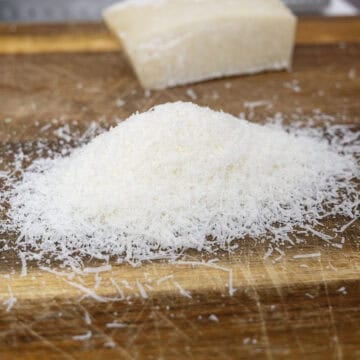
Before you start cooking, The Pecorino needs to be grated into the thinnest pieces your grater can make. This will prevent it from becoming globular when added to the sauce.

I also like to prepare my guanciale into strips like this. I feel like you get a whole lot of flavor in your mouth when you cut it this way compared to little squares.

Step 1: Place the guanciale strips in a frying pan and bring to medium heat. The fat will begin to render and the rest of the guanciale will become crisp and golden brown.

Step 2: Remove the guanciale from the pan with a slotted spoon, leaving at least 3 tablespoon of oil. Don't let the guanciale burn. It should have a reddish-brown tinge and appear as above when finished.
Would you like to save this recipe?

Step 3: Hand-squeeze the peeled tomatoes into the oil. Bring the sauce to a boil and then lower the heat to a simmer. Ground the fresh black pepper into the sauce.
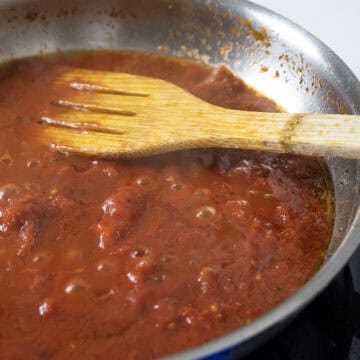
Step 4: Let the sauce simmer for 10 minutes. While it's simmering boil a large pot of water. Salt the water and add the bucatini. Cook until 1-2 minutes before al dente. Save pasta water for the sauce. Add ¼ cup of pasta water into the sauce and mix well.

Step 5: Toss the bucatini into the red sauce and let it simmer with the sauce for 2 minutes.

Step 6: Combine the pecorino with the pasta and sauce in the saucepan off the heat. Then serve immediately topping it with the guanciale.
Pro-Tips
- Always cook guanciale starting in a cold pan to render the fat and make the meat golden-brown and crispy.
- When simmering the sauce keep the pan at a high enough temperature to keep a strong simmer. Bring the sauce back to a simmer after you add the pasta water. The pasta needs to cook in the sauce to let the sauce soak into it. You can't just pour the sauce over the pasta in bucatini amatriciana.
- Make sure to save extra pasta water for this dish. You will finish cooking the pasta through in the sauce, and you may need to add a little more pasta water once it is al dente if the sauce gets too thick.
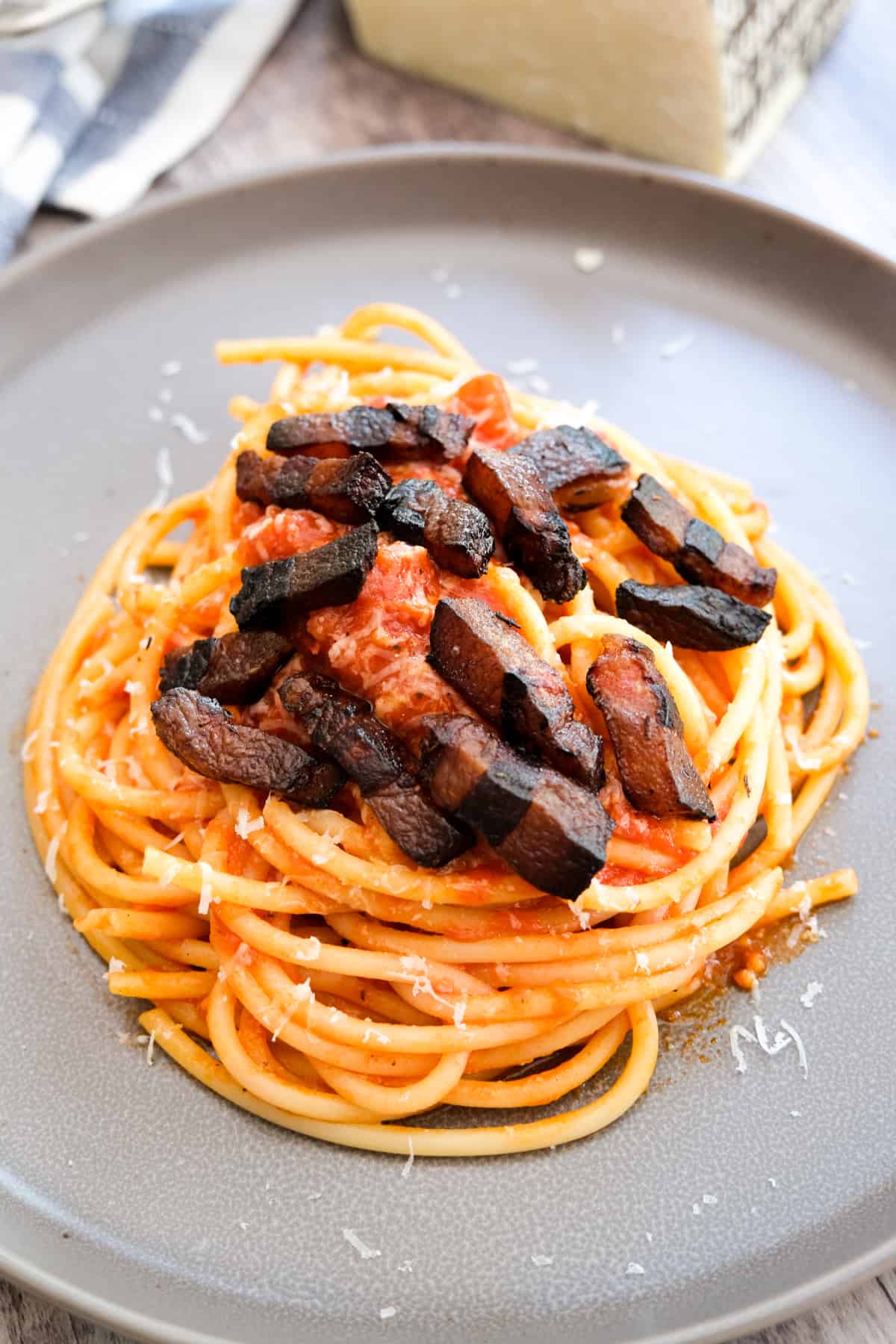
What to serve it with
Serve Bucatini amatriciana with some veggies and extra serving of protein!
- Serve with a chicken dish like Restaurant-Style Chicken Saltimbocca, Restaurant-Style Chicken Francese, or Fennel Chicken Thighs in Red Wine.
- Serve it with a pork or beef main dish. Some of our favorites are Authentic Italian Braciole, Italian Ring Sausage (Chevalatta), and Classic Italian Fried Meatballs!
- Always add a veggie to the side like Italian Lacinato Kale Recipe (Tuscan), Sauteed Rapini with Garlic, or Garlic Parmesan Green Beans.
Recipe FAQs
Guanciale is pork jowl while pancetta is cured pork belly. Guanciale tends to be a softer bite while pancetta will be slightly tougher. They have similar tastes but guanciale has a richer flavor.
Yes, bucatini has a tiny hole in the middle of the tubule which makes it great for amatriciana because the sauce can find its way through the pasta.
Some recipes call for it. But in the very classic original dish, the four ingredients were peeled plum tomatoes, guanciale, pecorino romano, and black pepper.
More Delicious Pasta
Be sure to leave a comment or review below! We love to hear from you! Follow us on Instagram @vindelgiudice or Tiktok @alwaysfromscratch.
📖 Recipe
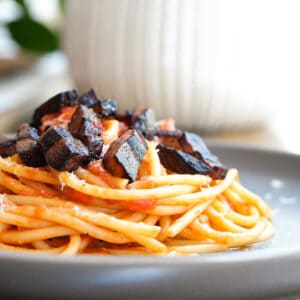
Bucatini Amatriciana
Equipment
- 1 large saucepan
Ingredients
- 6 oz guanciale
- ½ lb bucatini
- ⅔ cup pecorino romano
- 1 teaspoon black pepper
- 14 oz peeled tomatoes
Instructions
- Chop guanciale into strips or pieces. Place the guanciale in the saucepan and bring to medium heat. Fry for about 8 minutes or until the fat renders and the guanciale is golden brown. Remove from the pan, leaving at least 3 tablespoon of oil.
- Hand-squeeze the peeled tomatoes into the sauce. Ground fresh pepper into the sauce. Bring to a boil and then lower the heat to a simmer.
- Bring a large pot of water to a boil. Salt the water and add the bucatini. Cook until 1-2 minutes before al dente. Save pasta water for the sauce.
- Add ¼ cup of pasta water into the sauce and mix well. Drop in the bucatini and toss in the sauce. Let it simmer for 2 minutes.
- Add pecorino romano to the sauce and toss to combine. Serve immediately, adding the crispy guanciale on top of the pasta.
Notes
-
- Always cook guanciale starting in a cold pan to render the fat and make the meat golden-brown and crispy.
- When simmering the sauce keep the pan at a high enough temperature to keep a strong simmer. Bring the sauce back to a simmer after you add the pasta water.








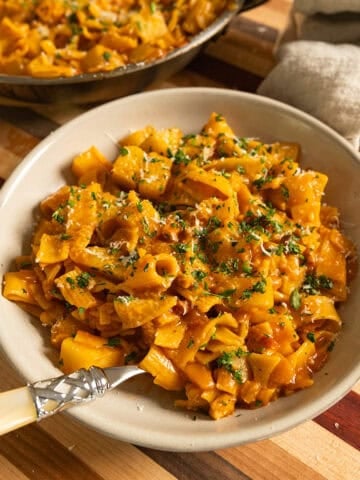
Vinny says
This is one of my favorite recipes to order when I go out to eat but I love making it at home! If you want to learn how to make it at home follow our recipe!